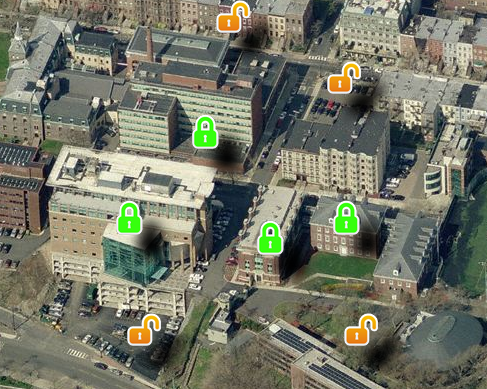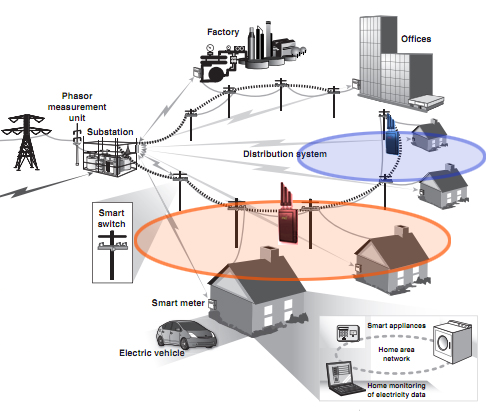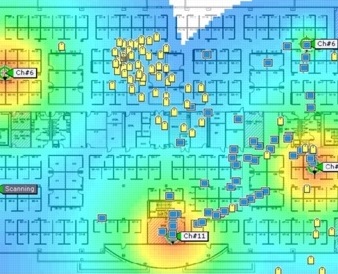
Exploiting Location as a New Dimension to Assist Wireless Security. As the increasingly pervasive wireless networks make it even easier to conduct attacks for new and rapidly evolving adversaries, the ubiquity of wireless is redefining security challenges. Thus, there is an urgent need to seek security solutions that can defend against attacks across the current heterogeneous mixes of wireless technologies. Location will be the cornerstone of new wireless services as future wireless services will support the access to resources and information from anywhere at anytime, implying that people will request services and information at different locations and at different times. In this project, we exploit location as a powerful information source to assist cryptographic-based methods to solve fundamental security problems such as detecting identity-based attacks and providing location-aware secure access of network resources.
This project is funded by the National Science Foundation, PI: Yingying Chen.

Utilizing Physical Layer Properties for Secret Key Extraction in Mobile Environments. Information sharing and various data transactions on wireless devices have become an inseparable part of our daily lives. However, securing wireless communication remains challenging in dynamic mobile environments due to the shared nature of wireless medium and lacking of fixed key management infrastructures. Generating secret keys using physical layer information thus has drawn much attention to complement traditional cryptographic-based methods. This project is designing schemes of secret key generation among wireless devices using physical layer information of radio channel such as the Received Signal Strength (RSS) and the Channel State Information (CSI). We currently are focusing on exploring the fine-grained physical layer information (i.e., CSI) from multiple subcarriers of Orthogonal Frequency-Division Multiplexing (OFDM) to achieve higher secret bit generation rate and make the secret key extraction approaches (based on physical-layer characteristics) more practical.
This project is partially supported Army Research Office, PI: Yingying Chen.

Building Self-Healing Smart Grid Under Jamming. A key component of a smart grid is its ability to collect useful information from a power grid for enabling control centers to estimate the current states of the power grid. Such information can be delivered to the control centers via wireless or wired networks. We envision that wireless technology will be widely used for local-area communication subsystems in the smart grid (e.g., in distribution networks). However, various attacks with drastic impacts can be launched in wireless networks such as channel jamming attacks and DoS attacks. In particular, jamming attacks can cause a wide range of damages to power grids, e.g., delayed delivery of time-critical messages can prevent control centers from properly controlling the outputs of generators to match load demands. We design a communication subsystem with enhanced self-healing capability under the presence of jamming through intelligent local controller switching. Our framework allows sufficient readings from smart meters to be continuously collected by various local controllers to estimate the states of a power grid under various attack scenarios. Additionally, we provide guidelines on optimal placement of local controllers to ensure effective switching of smart meters under jamming.

Securing Spectrum Usage in Future Radio Systems. The openness of the lower-layer protocol stacks renders cognitive radios (CR) an appealing solution to dynamic spectrum access (DSA). Its open nature will increase the flexibility of spectrum utilization and promote spectrally-efficient communication. Nevertheless, due to the exposure of the protocol stacks to the public, CR platforms can become a tempting target for adversaries or irresponsible secondary users. A misuse of a CR can significantly compromise the benefits of DSA and threaten the privileges of incumbent users. Therefore, having the ability to enforce spectrum etiquettes is critical in future radio systems. We are designing efficient mechanisms, and developing effective frameworks that can both detect anomalous activities in spectrum usage as well as localize adversaries without requiring overhead on wireless devices.
This project is funded by the National Science Foundation, PI: Yingying Chen.

SEMOIS: Secure Mobile Information Sharing System. This project aims to build a secure mobile information sharing system (SEMOIS) that supports secure and privacy-preserving real-time information sharing. SEMOIS will have the ability to store secure data items with flexible access control at insecure storage nodes and enables users to send context-based messages with late-binding features. Specifically, SEMOIS plans to achieve data confidentiality and privacy-preserving through data encryption and encrypted search, and enable intentional name based message dissemination without apriori knowledge of recipients. Additionally, a set of smart learning methods will be developed to extract short-term and long-term geo-social patterns from multimodal sensing data collected by mobile devices for social networking purposes, e.g., geo-social patterns are used to derive hidden social communities.
This project is funded by the National Science Foundation, PI: Yingying Chen.

MILAN: Multi-Modal Passive Intrusion Learning in Pervasive Wireless Environments. This project seeks to develop effective and scalable multi-modal passive intrusion learning techniques that have the capability to detect and track device-free moving objects in pervasive wireless environments through adaptive learning. In contrast to traditional techniques, which require pre-deployment of specialized hardware, and thus not easily deployed for unscheduled tasks and may not be scalable, this project leads to new insights into intrusion learning by mining on wireless environmental data, as well as leading to new approaches to device-free wireless localization, which can be used to assist a broad array of applications, e.g., identification of people trapped in a fire building during emergency evacuation.
This project is funded by the National Science Foundation, PI: Yingying Chen.
Smartphone Applications. Mobile apps, especially those location based ones, are changing the way people work and live every day, and many such apps have to deal with an indoor environment, e.g., shopping malls and airports. In many such environments, the availability of indoor location information can be used to help individuals (directions, just-in-time coupons/promotions) and organizations (passenger flow distribution in airports, customer shopping/movements' pattern in malls). All these apps would require a practical, robust and efficient smartphone indoor localization solution. We are studying a practical and energy efficient indoor localization solution leveraging multiple sensing modalities enabled by smartphones.

Anti-jamming. The increasing pervasiveness of wireless technologies, combined with the limited number of unlicensed bands, will continue to make the radio environment crowded, leading to unintentional radio interference across devices with different communication technologies that share the same spectrum. Meanwhile, the emerging of software defined radios has enabled adversaries to build intentional jammers to disrupt network communication with little effort. To ensure the successful deployment of pervasive wireless networks, we take the view point that it is crucial to localize jammers, since the locations of jammers allow a better physical arrangement of wireless devices that cause unintentional radio interference, and enable a wide range of defense strategies for combating malicious jamming attackers.